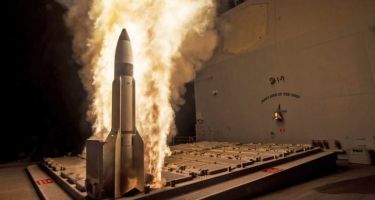Insights on the Worldwide Remotely Operated Weapon Stations Industry - Market & Technology Forecast to 2029 - ResearchAndMarkets.com
The "Global Remotely Operated Weapon Stations - Market and Technology Forecast to 2029" report has been added to ResearchAndMarkets.com's offering.
After two years of use in the field, Remotely Operated Weapon Stations have been well established in the defense market. The advantages they offer are significant. They include crew protection, increased accuracy, first-round hit probability, target recognition and identification, low cost of production; integration and operation. The US Armed Forces have been at the forefront of ROWS induction into its force structure. More than 20,000 units have been procured so far and additional ones are due to be delivered in the coming years.
There are two very important developments in the ROWS market that no one should disregard, as they are expected to change the conduct of combat operations. Just as radio brought a small revolution in technical and military affairs when it was used as a medium to guide weapons, ROWS will bring a similar change, not only as standalone systems but also as part of a networked environment and on top of the unmanned ground or surface vehicles.
The current global security environment poses many challenges either in the form of low-intensity conflicts or between peer opponents. With major forces around the globe being in need of fielding disruptive technologies with fire delivery capabilities, platforms, or unmanned systems with ROWS, interconnected through a C4ISR backbone, will serve that goal effectively and affordably.
Companies Mentioned
- Aselsan
- BAE Systems
- CMI Defence - Cockerill
- Elbit
- EOS Australia
- FN Herstal
- General Dynamics
- KMW
- Kongsberg
- Leonardo
- MSI-Defence Systems
- Nexter
- Rafael
- Rheinmetall
- Saab
- Thales
Key Topics Covered:
1 Introduction
2 Executive Summary
3 Current ROWS Technologies/Market Overview
4 Market Analysis
4.1 Introduction
4.2 Forecast factors - Drivers
4.2.1 Driver 1 - Defense budgets
4.2.2 Driver 2 - Increased market interest in wheeled (armored) vehicles
4.2.3 Driver 3 - Requirement for persistent ISR
4.2.4 Driver 4 - Worldwide asymmetric threats
4.2.5 Driver 5 - Navies to increasingly operate at the littoral waters
4.2.6 Driver 6 - Need for Coast Guard forces
4.2.7 Driver 7 - Indigenous defense industries and production issues
4.2.8 Driver 8 - Increased range of engagements and accuracy
4.2.9 Driver 9 - Combined effects
4.2.10 Driver 10 - Power management systems development
4.2.11 Driver 11 - Crew survivability
4.2.12 Driver 12 - Proliferation of UGVs and UUVs
4.2.13 Driver 13 - Need to upgrade legacy platforms
4.2.14 Driver 14 - Urban warfare is a reality
4.2.15 Driver 15 - Evolution of Artificial Intelligence
4.2.16 Driver 16 - ROWS with non-lethal weapons
4.2.17 Driver 17 - ROWS costs availability
4.3 Forecast factors - Inhibitors
4.3.1 Inhibitor 1 - Lack of proven concept of operations
4.3.2 Inhibitor 2 - Trust in manned solutions
4.3.3 Inhibitor 3 - Defense budgets
4.3.4 Inhibitor 4 - Artificial Intelligence and Ethics
4.3.5 Inhibitor 5 - Rules of engagement and International law
4.3.6 Inhibitor 6 - Export control of defense technology
4.4 Opportunities
4.4.1 Opportunity 1 - Improving EO/IR technology
4.4.2 Opportunity 2 - Improving unmanned systems testing and evaluation
4.4.3 Opportunity 3 - Improving Manned-Unmanned Teaming
4.4.4 Opportunity 4 - Improving Marketing and Value-Added Messages
4.4.5 Opportunity 5 - Develop ways to extend the lifespan and capabilities of platforms
4.4.6 Opportunity 6 - A single control station must be able to concurrently operate multiple unmanned systems
4.4.7 Opportunity 7 - Multiple effects by a single ROWS
4.4.8 Opportunity 8 - ROWS adaptable for homeland security use
4.4.9 Opportunity 9 - ROWS as systems
4.4.10 Opportunity 10 - Field training for ROWS operators with augmented or virtual reality
4.4.11 Opportunity 11 - Training for ROWS drives need for simulators and virtual environment
4.4.12 Opportunity 12 - Continuous development of power management and battery systems
4.4.13 Opportunity 13 - Field 3D printing of spare parts
4.5 Opportunities
4.5.1 Time Sensitive Opportunity 1 - Romanian Army new wheeled IFV
4.5.2 Time Sensitive Opportunity 2 - Bulgarian Army new wheeled IFV
4.5.3 Time Sensitive Opportunity 3 - British Army new armored vehicles
4.5.4 Time Sensitive Opportunity 4 - Latvian Army new vehicles
4.5.5 Time Sensitive Opportunity 5 - Lithuanian Army IFV procurement
4.5.6 Time Sensitive Opportunity 6 - Hellenic Armed Forces
4.5.7 Time Sensitive Opportunity 7 - Finnish Army vehicles
4.5.8 Time Sensitive Opportunity 8 - Polish Army vehicles
4.5.9 Time Sensitive Opportunity 9 - Pakistan Army 4x4 armored vehicles
4.5.10 Time Sensitive Opportunity 10 - Japanese Army 8x8 APCs
4.5.11 Time Sensitive Opportunity 11 - Kuwaiti Army M-1 Abrams upgrade
4.6 Porter's 5 Forces Analysis
4.7 Macro environment
5 Forecast ROWS Market by Region to 2029
5.1 Introduction
5.2 Americas - ROWS Market Forecast to 2029
5.3 Europe - ROWS Market Forecast to 2029
5.4 Middle East & Africa - ROWS Market Forecast to 2029
5.5 Asia-Pacific - ROWS Market Forecast to 2029
6 Forecast ROWS Market by End-User to 2029
7 Forecast ROWS Market by System-Element to 2029
9 Leading Companies in the ROWS Market
10 Conclusions and recommendations
11 About the Publisher
12 Appendices
For more information about this report visit https://www.researchandmarkets.com/r/anwekv
View source version on businesswire.com: https://www.businesswire.com/news/home/20210111005543/en/






